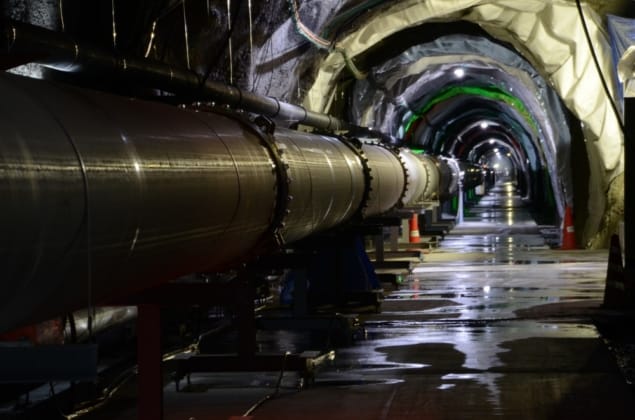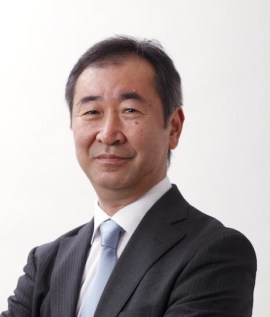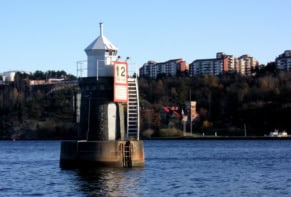In the run-up to the announcement of the 2021 Nobel Prize for Physics on 5 October, we’re running a series of blog posts looking at previous recipients and what they did after their Nobel prize-winning work. Michael Banks talks to neutrino pioneer Takaaki Kajita about the move into gravitational-wave research.

For the past half a century, Japan has led the world in neutrino science. In the 1980s the Japanese physicist Masatoshi Koshiba masterminded the construction of a huge neutrino detector located 1000 m underground in a lead and zinc mine in Japan in Hida, Gifu Prefecture. Called Kamiokande, it was an enormous water tank surrounded by photomultiplier tubes to detect the flashes of light produced when neutrinos interacted with atomic nuclei in water molecules.
Koshiba famously used the experiment to detect neutrinos from a distant supernova explosion – in the process becoming one of the founders of neutrino astronomy. The work led him to sharing the 2002 Nobel Prize for Physics for the detection of cosmic neutrinos.

Takaaki Kajita – who was still a physics student when Koshiba did his Nobel-prize-winning work – was intrigued by the study of these ghostly particles and decided to carry out a PhD at the University of Tokyo under the supervision of Koshiba. The work fascinated him enough such that in 1988, Kajita joined the Institute for Cosmic Ray Research (ICRR) at the University of Tokyo where he spent the next two decades working on neutrino physics.
In 1996, Kamiokande’s successor – the Super-Kamiokande experiment – began operation and two years later, Kajita played a key role in using the facility to show that the ratio of electron to muon neutrinos coming from opposite sides of the Earth were different. This meant that these neutrinos – created when cosmic rays interact with nuclei in the upper atmosphere – were changing flavour as they passed through the Earth. This showed, for the first time, that neutrinos must have mass, albeit at only about 0.1 eV.
Science has become so important for deciding the direction of society – or even the future of the Earth
For the work, Kajita followed in Koshiba’s footsteps and in 2015 shared half that year’s physics Nobel with the neutrino physicist Arthur McDonald “for the discovery of neutrino oscillations, which shows that neutrinos have mass”. Experiments at the Sudbury Neutrino Observatory (SNO), led by McDonald, determined how many of the electron neutrinos produced in the Sun change into muon neutrinos or tau neutrinos as they travel to the Earth. SNO data were able to confirm the fact that about two-thirds of the solar electron neutrinos change flavour by the time they reach the Earth.
Switching fields
Despite adding to Japan’s rich legacy in neutrino physics, in 2008 – before Kajita was awarded the Nobel prize – he made a bold decision to switch research fields. “After many years of neutrino research, I wanted to do something new that would be important and exciting,” Kajita told Physics World. “Fortunately, our institute had been planning a gravitational-wave project as the next major project to come after Super-Kamiokande.” That facility was the KAGRA gravitational-wave observatory, which would be based underground nearby Super-Kamiokande.
Kajita became director of ICRR in 2008 and played a major role in getting KAGRA funded and constructed. KAGRA is a huge interferometer in which a laser beam is split down two 3 km-long arms. The beams are reflected multiple times between mirrors suspended at the ends of each arm and then combined at a detector. A gravitational wave is a ripple in space–time and when it passes through an interferometer, it can change the distances between the mirrors. This is detected as a change in how the laser light interferes at the detector.
Construction of KAGRA, which is based 200 m underground, began in 2010 and became operational in 2020. Given the impact of COVID-19, KAGRA is expected to join the international hunt for gravitational waves next year. Kajita is currently the project’s principal investigator. Art McDonald and Takaaki Kajita win 2015 Nobel Prize for Physics
As well as switching research fields, Kajita also delved into other aspects of science, becoming a member of the Science Council of Japan (SCJ) in 2017. The role of the SCJ is to make recommendations to the government and wider society about certain issues. In 2020 he was nominated by the other SCJ members as its president. “I do not know why many of them voted to me,” admits Kajita. “But I guess that the Nobel prize had some influence on the vote!”
Kajita says he joined the SCJ to communicate the importance of basic science to the public and indicates that can be as important as doing the science itself. “Science has become so important for deciding the direction of society – or even the future of the Earth,” he says. “Physics is clearly one of the important parts of science. So I hope that physicists dedicate their time for other activities such as science policy.”
Physics World‘s Nobel prize coverage is supported by Oxford Instruments Nanoscience, a leading supplier of research tools for the development of quantum technologies, advanced materials and nanoscale devices. Visit nanoscience.oxinst.com to find out more.




